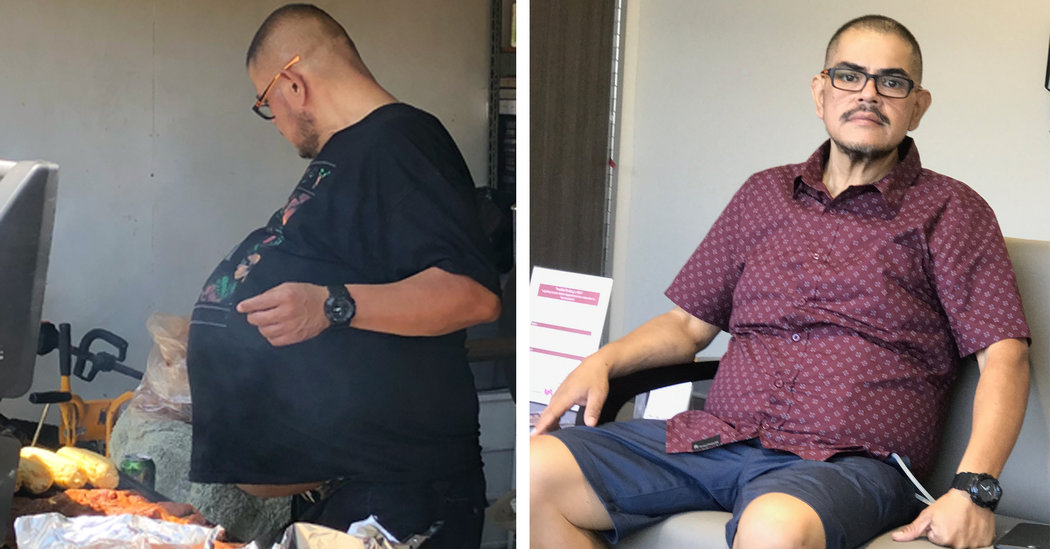
For months, Hector Hernandez, 47, didn’t understand why his stomach had gotten so big.
“I just thought I was fat,” he said. “I’ve always been a big guy.”
It would be a year and a half before he discovered that his large belly was actually a 77-pound tumor. In the meantime, he watched as it grew and grew.
When he took the Los Angeles Metro to work every morning, people would stare.
“I wore big jackets to try to cover up, but it was very noticeable,” he said in an interview on Wednesday.
And when he sat at his desk, where he did billing for an information technology company, “my stomach would just lay between my legs,” he said.
Some assumed he was overly fond of beer.
One day a man approached him at a Circle K convenience store near where Mr. Hernandez lives in Downey, Calif., rubbed his stomach and told him he shouldn’t drink, because “it’s not good for you,” Mr. Hernandez said.
“And I just laughed and said, ‘You know what, I don’t drink,’” he said.
He also doesn’t overeat, but Mr. Hernandez tried a plant-based diet, hoping it would make a difference.
It didn’t.
His stomach kept growing until it became so voluminous, it resembled “a beach ball” and he couldn’t bend over to tie his shoelaces.
But while his stomach kept expanding, the rest of his body was getting thinner.
[Like the Science Times page on Facebook. | Sign up for the Science Times newsletter.]
Worried about his appearance, in 2016 he went to see a doctor, who told him that some people “just gain weight differently.” He sought a second opinion the next year, and was eventually referred to Dr. William Tseng, a surgical oncologist with Keck Medicine at the University of Southern California.
Testing revealed that Mr. Hernandez had liposarcoma, a rare form of cancer that originates in fat cells and had developed into a large tumor in his abdomen.
Although the tumor itself wasn’t painful, Mr. Hernandez had high blood pressure and was experiencing shortness of breath, constipation and constant heartburn, all symptoms that could now be attributed to the sarcoma.
“I was kind of in shock,” he said.
During a six-hour operation in July, Dr. Tseng removed the tumor, which weighed in at 77 pounds.
“It’s the biggest I’ve ever seen,” said Dr. Tseng, one of a few doctors in the United States who specialize in removing large soft-tissue sarcomas. Typically, he added, tumors like these are 20 to 30 pounds.
Fortunately, the “slow-growing giant beast” hadn’t spread to other parts of Mr. Hernandez’s body, Dr. Tseng said, but the surgical team did have to remove one of his kidneys.
“The tumor swallowed it up, basically,” Mr. Hernandez said of the kidney. “It wasn’t functioning anymore.”
Doctors don’t know why such sarcomas form or how to stop them.
“We don’t have anything that can prevent it at this point,” Dr. Tseng said.
Unfortunately, Mr. Hernandez has been told the liposarcoma will most likely return.
And if that happens, the cancer could become more aggressive. The only solution is more surgery, Dr. Tseng said, adding that he hoped this type of disease — while unusual — would be subject to more research.
“We desperately need something better than surgery,” he said.
Mr. Hernandez will undergo CT scans every four months to monitor his condition. He now faces thousands of dollars in medical bills and is asking for donations via GoFundMe.
Since the surgery, his symptoms have disappeared and he’s about “90 percent” back to normal.
“Oh my God, I feel great,” he said, later adding, “I think I just need to build up my strength.”

